NURSING 5 Report: Gender, Depression, and Pregnancy Outcomes
VerifiedAdded on 2022/09/15
|9
|2035
|10
Report
AI Summary
This report examines the prevalence and impact of depression among pregnant women, highlighting the significant role of gender differences. It explores how socio-demographic factors, such as ethnicity, marital status, and socio-economic status, influence the development of depression during pregnancy. The study emphasizes the vulnerability of women with poor socio-economic conditions to antenatal and postnatal depression, often exacerbated by factors like domestic violence and lack of social support. The report further discusses the importance of early intervention and the application of the Social Ecological Model (SEM) to address and overcome depression, promoting community-level activities and interventions to improve the mental health outcomes of pregnant women.
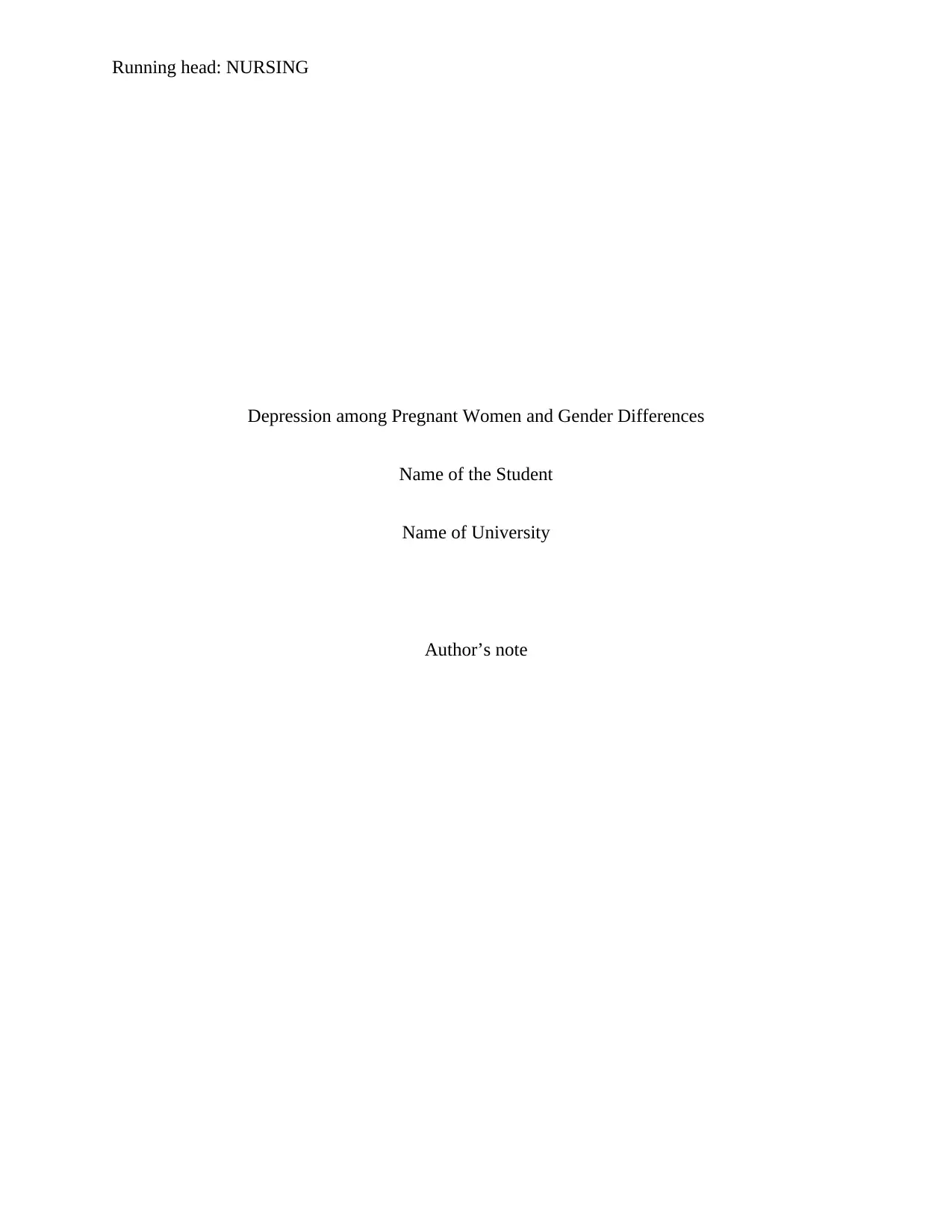
Running head: NURSING
Depression among Pregnant Women and Gender Differences
Name of the Student
Name of University
Author’s note
Depression among Pregnant Women and Gender Differences
Name of the Student
Name of University
Author’s note
Paraphrase This Document
Need a fresh take? Get an instant paraphrase of this document with our AI Paraphraser
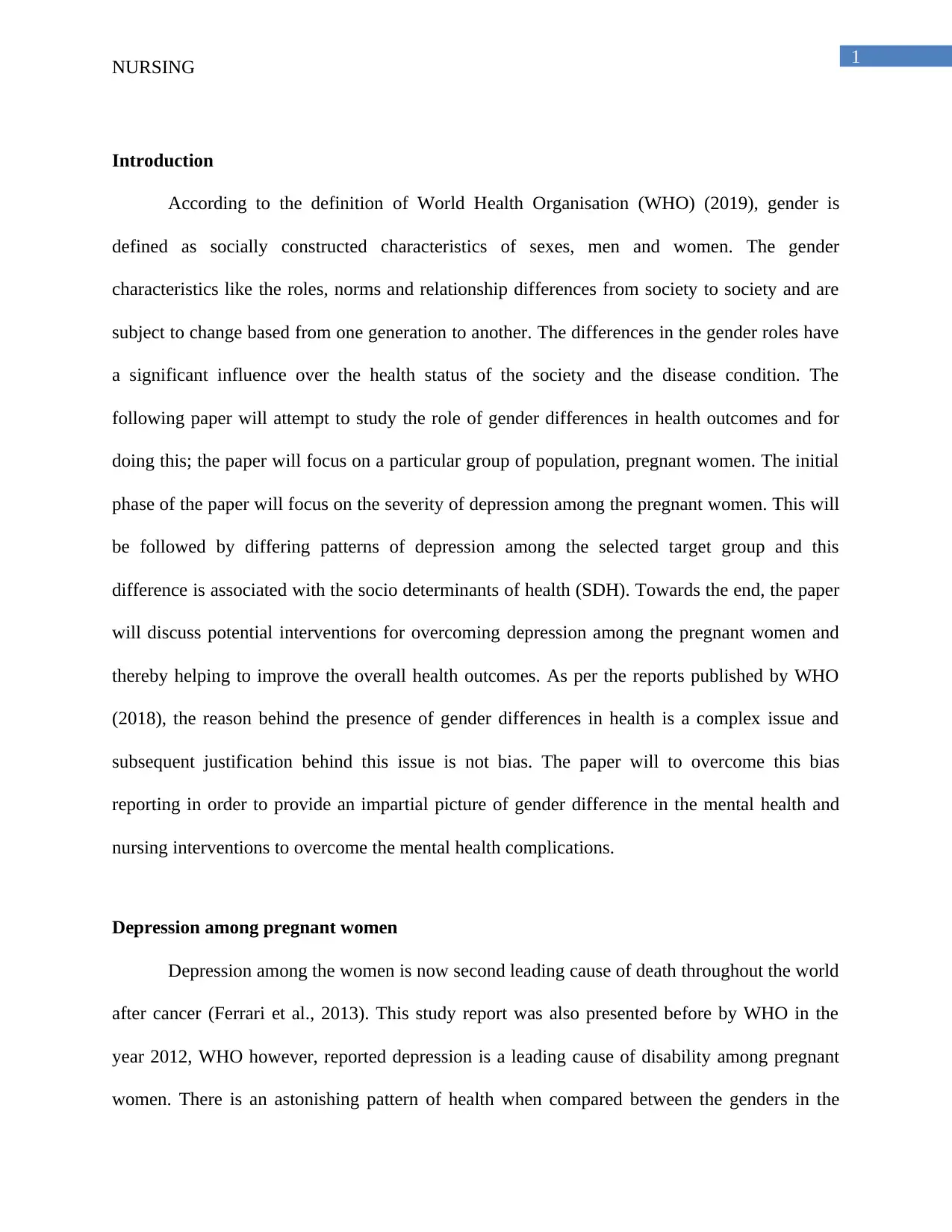
1
NURSING
Introduction
According to the definition of World Health Organisation (WHO) (2019), gender is
defined as socially constructed characteristics of sexes, men and women. The gender
characteristics like the roles, norms and relationship differences from society to society and are
subject to change based from one generation to another. The differences in the gender roles have
a significant influence over the health status of the society and the disease condition. The
following paper will attempt to study the role of gender differences in health outcomes and for
doing this; the paper will focus on a particular group of population, pregnant women. The initial
phase of the paper will focus on the severity of depression among the pregnant women. This will
be followed by differing patterns of depression among the selected target group and this
difference is associated with the socio determinants of health (SDH). Towards the end, the paper
will discuss potential interventions for overcoming depression among the pregnant women and
thereby helping to improve the overall health outcomes. As per the reports published by WHO
(2018), the reason behind the presence of gender differences in health is a complex issue and
subsequent justification behind this issue is not bias. The paper will to overcome this bias
reporting in order to provide an impartial picture of gender difference in the mental health and
nursing interventions to overcome the mental health complications.
Depression among pregnant women
Depression among the women is now second leading cause of death throughout the world
after cancer (Ferrari et al., 2013). This study report was also presented before by WHO in the
year 2012, WHO however, reported depression is a leading cause of disability among pregnant
women. There is an astonishing pattern of health when compared between the genders in the
NURSING
Introduction
According to the definition of World Health Organisation (WHO) (2019), gender is
defined as socially constructed characteristics of sexes, men and women. The gender
characteristics like the roles, norms and relationship differences from society to society and are
subject to change based from one generation to another. The differences in the gender roles have
a significant influence over the health status of the society and the disease condition. The
following paper will attempt to study the role of gender differences in health outcomes and for
doing this; the paper will focus on a particular group of population, pregnant women. The initial
phase of the paper will focus on the severity of depression among the pregnant women. This will
be followed by differing patterns of depression among the selected target group and this
difference is associated with the socio determinants of health (SDH). Towards the end, the paper
will discuss potential interventions for overcoming depression among the pregnant women and
thereby helping to improve the overall health outcomes. As per the reports published by WHO
(2018), the reason behind the presence of gender differences in health is a complex issue and
subsequent justification behind this issue is not bias. The paper will to overcome this bias
reporting in order to provide an impartial picture of gender difference in the mental health and
nursing interventions to overcome the mental health complications.
Depression among pregnant women
Depression among the women is now second leading cause of death throughout the world
after cancer (Ferrari et al., 2013). This study report was also presented before by WHO in the
year 2012, WHO however, reported depression is a leading cause of disability among pregnant
women. There is an astonishing pattern of health when compared between the genders in the
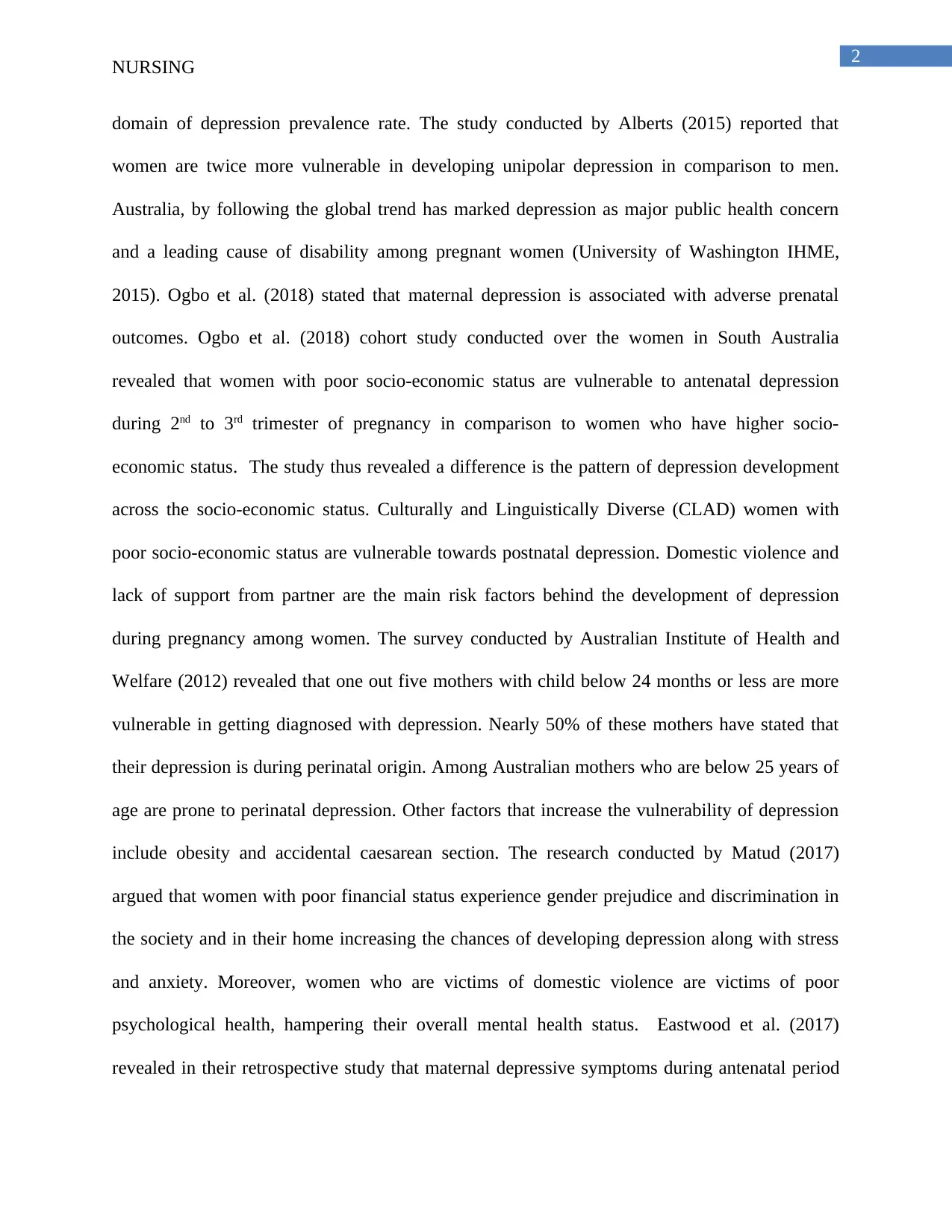
2
NURSING
domain of depression prevalence rate. The study conducted by Alberts (2015) reported that
women are twice more vulnerable in developing unipolar depression in comparison to men.
Australia, by following the global trend has marked depression as major public health concern
and a leading cause of disability among pregnant women (University of Washington IHME,
2015). Ogbo et al. (2018) stated that maternal depression is associated with adverse prenatal
outcomes. Ogbo et al. (2018) cohort study conducted over the women in South Australia
revealed that women with poor socio-economic status are vulnerable to antenatal depression
during 2nd to 3rd trimester of pregnancy in comparison to women who have higher socio-
economic status. The study thus revealed a difference is the pattern of depression development
across the socio-economic status. Culturally and Linguistically Diverse (CLAD) women with
poor socio-economic status are vulnerable towards postnatal depression. Domestic violence and
lack of support from partner are the main risk factors behind the development of depression
during pregnancy among women. The survey conducted by Australian Institute of Health and
Welfare (2012) revealed that one out five mothers with child below 24 months or less are more
vulnerable in getting diagnosed with depression. Nearly 50% of these mothers have stated that
their depression is during perinatal origin. Among Australian mothers who are below 25 years of
age are prone to perinatal depression. Other factors that increase the vulnerability of depression
include obesity and accidental caesarean section. The research conducted by Matud (2017)
argued that women with poor financial status experience gender prejudice and discrimination in
the society and in their home increasing the chances of developing depression along with stress
and anxiety. Moreover, women who are victims of domestic violence are victims of poor
psychological health, hampering their overall mental health status. Eastwood et al. (2017)
revealed in their retrospective study that maternal depressive symptoms during antenatal period
NURSING
domain of depression prevalence rate. The study conducted by Alberts (2015) reported that
women are twice more vulnerable in developing unipolar depression in comparison to men.
Australia, by following the global trend has marked depression as major public health concern
and a leading cause of disability among pregnant women (University of Washington IHME,
2015). Ogbo et al. (2018) stated that maternal depression is associated with adverse prenatal
outcomes. Ogbo et al. (2018) cohort study conducted over the women in South Australia
revealed that women with poor socio-economic status are vulnerable to antenatal depression
during 2nd to 3rd trimester of pregnancy in comparison to women who have higher socio-
economic status. The study thus revealed a difference is the pattern of depression development
across the socio-economic status. Culturally and Linguistically Diverse (CLAD) women with
poor socio-economic status are vulnerable towards postnatal depression. Domestic violence and
lack of support from partner are the main risk factors behind the development of depression
during pregnancy among women. The survey conducted by Australian Institute of Health and
Welfare (2012) revealed that one out five mothers with child below 24 months or less are more
vulnerable in getting diagnosed with depression. Nearly 50% of these mothers have stated that
their depression is during perinatal origin. Among Australian mothers who are below 25 years of
age are prone to perinatal depression. Other factors that increase the vulnerability of depression
include obesity and accidental caesarean section. The research conducted by Matud (2017)
argued that women with poor financial status experience gender prejudice and discrimination in
the society and in their home increasing the chances of developing depression along with stress
and anxiety. Moreover, women who are victims of domestic violence are victims of poor
psychological health, hampering their overall mental health status. Eastwood et al. (2017)
revealed in their retrospective study that maternal depressive symptoms during antenatal period
⊘ This is a preview!⊘
Do you want full access?
Subscribe today to unlock all pages.

Trusted by 1+ million students worldwide
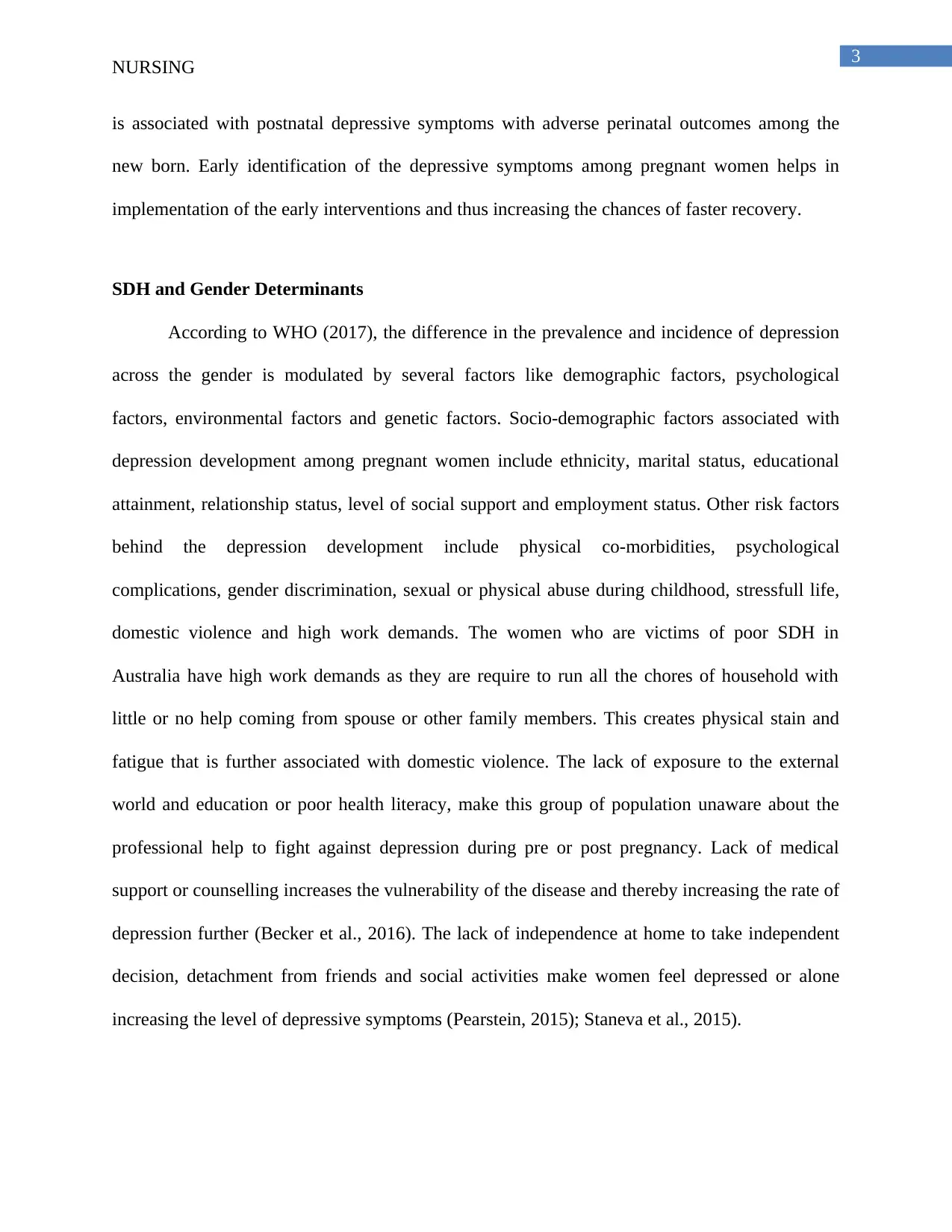
3
NURSING
is associated with postnatal depressive symptoms with adverse perinatal outcomes among the
new born. Early identification of the depressive symptoms among pregnant women helps in
implementation of the early interventions and thus increasing the chances of faster recovery.
SDH and Gender Determinants
According to WHO (2017), the difference in the prevalence and incidence of depression
across the gender is modulated by several factors like demographic factors, psychological
factors, environmental factors and genetic factors. Socio-demographic factors associated with
depression development among pregnant women include ethnicity, marital status, educational
attainment, relationship status, level of social support and employment status. Other risk factors
behind the depression development include physical co-morbidities, psychological
complications, gender discrimination, sexual or physical abuse during childhood, stressfull life,
domestic violence and high work demands. The women who are victims of poor SDH in
Australia have high work demands as they are require to run all the chores of household with
little or no help coming from spouse or other family members. This creates physical stain and
fatigue that is further associated with domestic violence. The lack of exposure to the external
world and education or poor health literacy, make this group of population unaware about the
professional help to fight against depression during pre or post pregnancy. Lack of medical
support or counselling increases the vulnerability of the disease and thereby increasing the rate of
depression further (Becker et al., 2016). The lack of independence at home to take independent
decision, detachment from friends and social activities make women feel depressed or alone
increasing the level of depressive symptoms (Pearstein, 2015); Staneva et al., 2015).
NURSING
is associated with postnatal depressive symptoms with adverse perinatal outcomes among the
new born. Early identification of the depressive symptoms among pregnant women helps in
implementation of the early interventions and thus increasing the chances of faster recovery.
SDH and Gender Determinants
According to WHO (2017), the difference in the prevalence and incidence of depression
across the gender is modulated by several factors like demographic factors, psychological
factors, environmental factors and genetic factors. Socio-demographic factors associated with
depression development among pregnant women include ethnicity, marital status, educational
attainment, relationship status, level of social support and employment status. Other risk factors
behind the depression development include physical co-morbidities, psychological
complications, gender discrimination, sexual or physical abuse during childhood, stressfull life,
domestic violence and high work demands. The women who are victims of poor SDH in
Australia have high work demands as they are require to run all the chores of household with
little or no help coming from spouse or other family members. This creates physical stain and
fatigue that is further associated with domestic violence. The lack of exposure to the external
world and education or poor health literacy, make this group of population unaware about the
professional help to fight against depression during pre or post pregnancy. Lack of medical
support or counselling increases the vulnerability of the disease and thereby increasing the rate of
depression further (Becker et al., 2016). The lack of independence at home to take independent
decision, detachment from friends and social activities make women feel depressed or alone
increasing the level of depressive symptoms (Pearstein, 2015); Staneva et al., 2015).
Paraphrase This Document
Need a fresh take? Get an instant paraphrase of this document with our AI Paraphraser
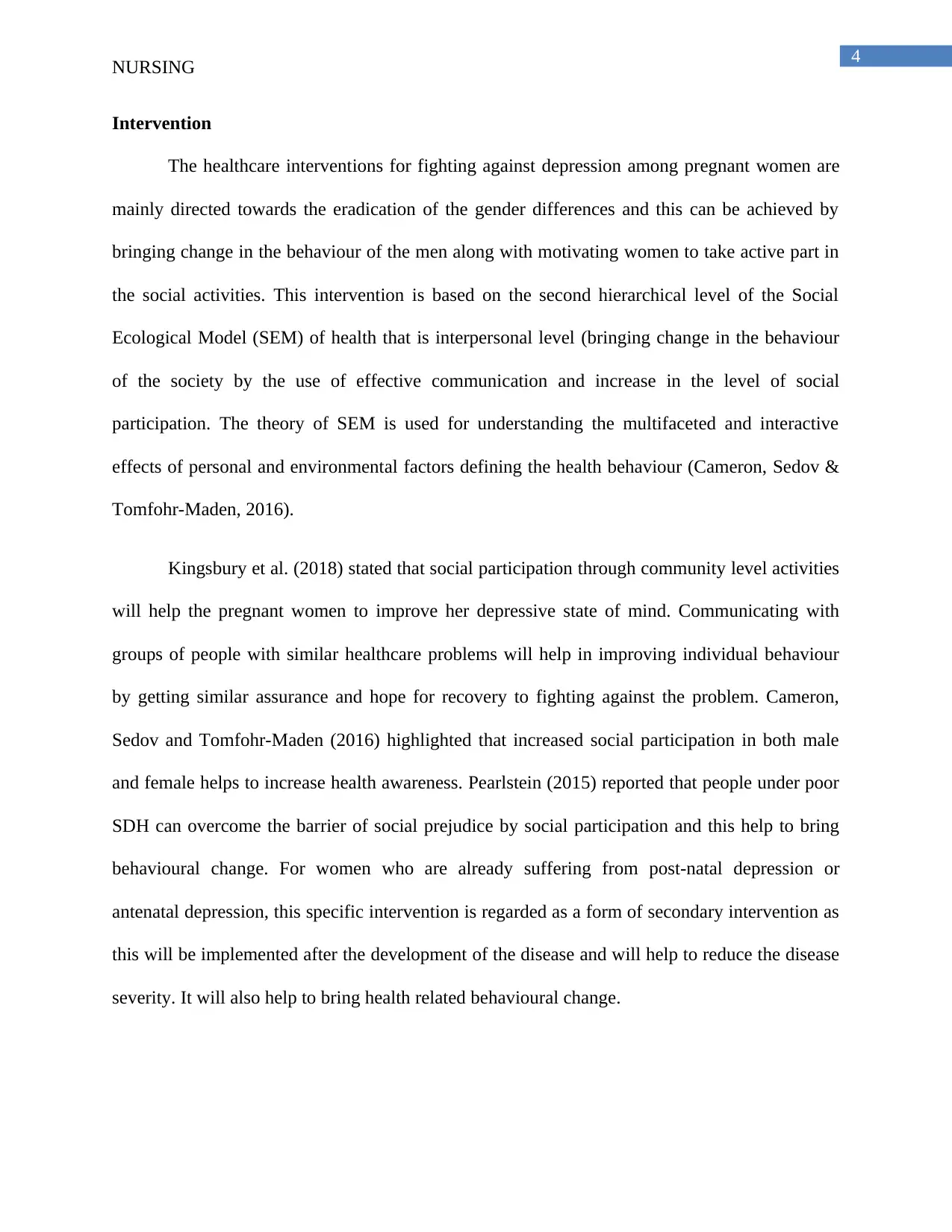
4
NURSING
Intervention
The healthcare interventions for fighting against depression among pregnant women are
mainly directed towards the eradication of the gender differences and this can be achieved by
bringing change in the behaviour of the men along with motivating women to take active part in
the social activities. This intervention is based on the second hierarchical level of the Social
Ecological Model (SEM) of health that is interpersonal level (bringing change in the behaviour
of the society by the use of effective communication and increase in the level of social
participation. The theory of SEM is used for understanding the multifaceted and interactive
effects of personal and environmental factors defining the health behaviour (Cameron, Sedov &
Tomfohr-Maden, 2016).
Kingsbury et al. (2018) stated that social participation through community level activities
will help the pregnant women to improve her depressive state of mind. Communicating with
groups of people with similar healthcare problems will help in improving individual behaviour
by getting similar assurance and hope for recovery to fighting against the problem. Cameron,
Sedov and Tomfohr-Maden (2016) highlighted that increased social participation in both male
and female helps to increase health awareness. Pearlstein (2015) reported that people under poor
SDH can overcome the barrier of social prejudice by social participation and this help to bring
behavioural change. For women who are already suffering from post-natal depression or
antenatal depression, this specific intervention is regarded as a form of secondary intervention as
this will be implemented after the development of the disease and will help to reduce the disease
severity. It will also help to bring health related behavioural change.
NURSING
Intervention
The healthcare interventions for fighting against depression among pregnant women are
mainly directed towards the eradication of the gender differences and this can be achieved by
bringing change in the behaviour of the men along with motivating women to take active part in
the social activities. This intervention is based on the second hierarchical level of the Social
Ecological Model (SEM) of health that is interpersonal level (bringing change in the behaviour
of the society by the use of effective communication and increase in the level of social
participation. The theory of SEM is used for understanding the multifaceted and interactive
effects of personal and environmental factors defining the health behaviour (Cameron, Sedov &
Tomfohr-Maden, 2016).
Kingsbury et al. (2018) stated that social participation through community level activities
will help the pregnant women to improve her depressive state of mind. Communicating with
groups of people with similar healthcare problems will help in improving individual behaviour
by getting similar assurance and hope for recovery to fighting against the problem. Cameron,
Sedov and Tomfohr-Maden (2016) highlighted that increased social participation in both male
and female helps to increase health awareness. Pearlstein (2015) reported that people under poor
SDH can overcome the barrier of social prejudice by social participation and this help to bring
behavioural change. For women who are already suffering from post-natal depression or
antenatal depression, this specific intervention is regarded as a form of secondary intervention as
this will be implemented after the development of the disease and will help to reduce the disease
severity. It will also help to bring health related behavioural change.
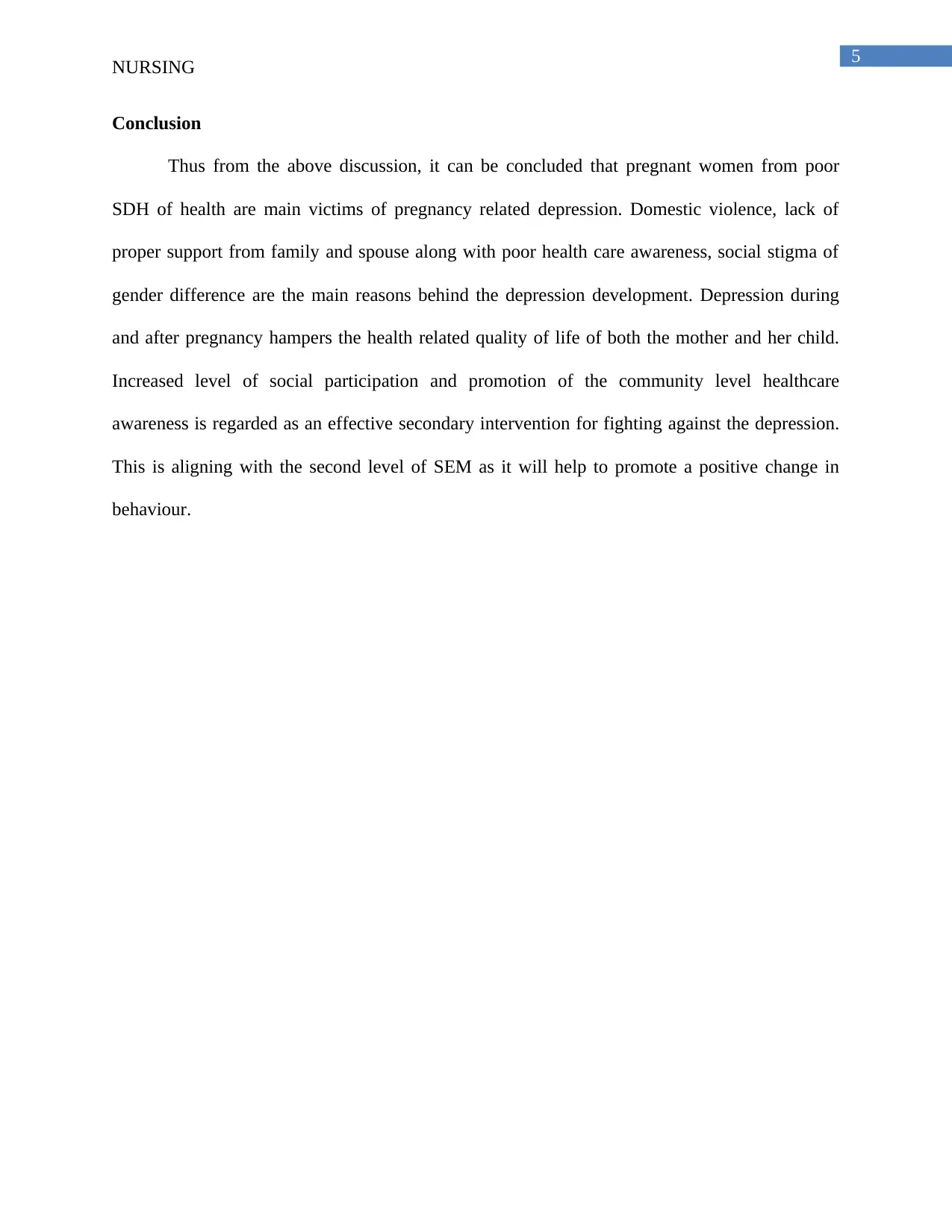
5
NURSING
Conclusion
Thus from the above discussion, it can be concluded that pregnant women from poor
SDH of health are main victims of pregnancy related depression. Domestic violence, lack of
proper support from family and spouse along with poor health care awareness, social stigma of
gender difference are the main reasons behind the depression development. Depression during
and after pregnancy hampers the health related quality of life of both the mother and her child.
Increased level of social participation and promotion of the community level healthcare
awareness is regarded as an effective secondary intervention for fighting against the depression.
This is aligning with the second level of SEM as it will help to promote a positive change in
behaviour.
NURSING
Conclusion
Thus from the above discussion, it can be concluded that pregnant women from poor
SDH of health are main victims of pregnancy related depression. Domestic violence, lack of
proper support from family and spouse along with poor health care awareness, social stigma of
gender difference are the main reasons behind the depression development. Depression during
and after pregnancy hampers the health related quality of life of both the mother and her child.
Increased level of social participation and promotion of the community level healthcare
awareness is regarded as an effective secondary intervention for fighting against the depression.
This is aligning with the second level of SEM as it will help to promote a positive change in
behaviour.
⊘ This is a preview!⊘
Do you want full access?
Subscribe today to unlock all pages.

Trusted by 1+ million students worldwide
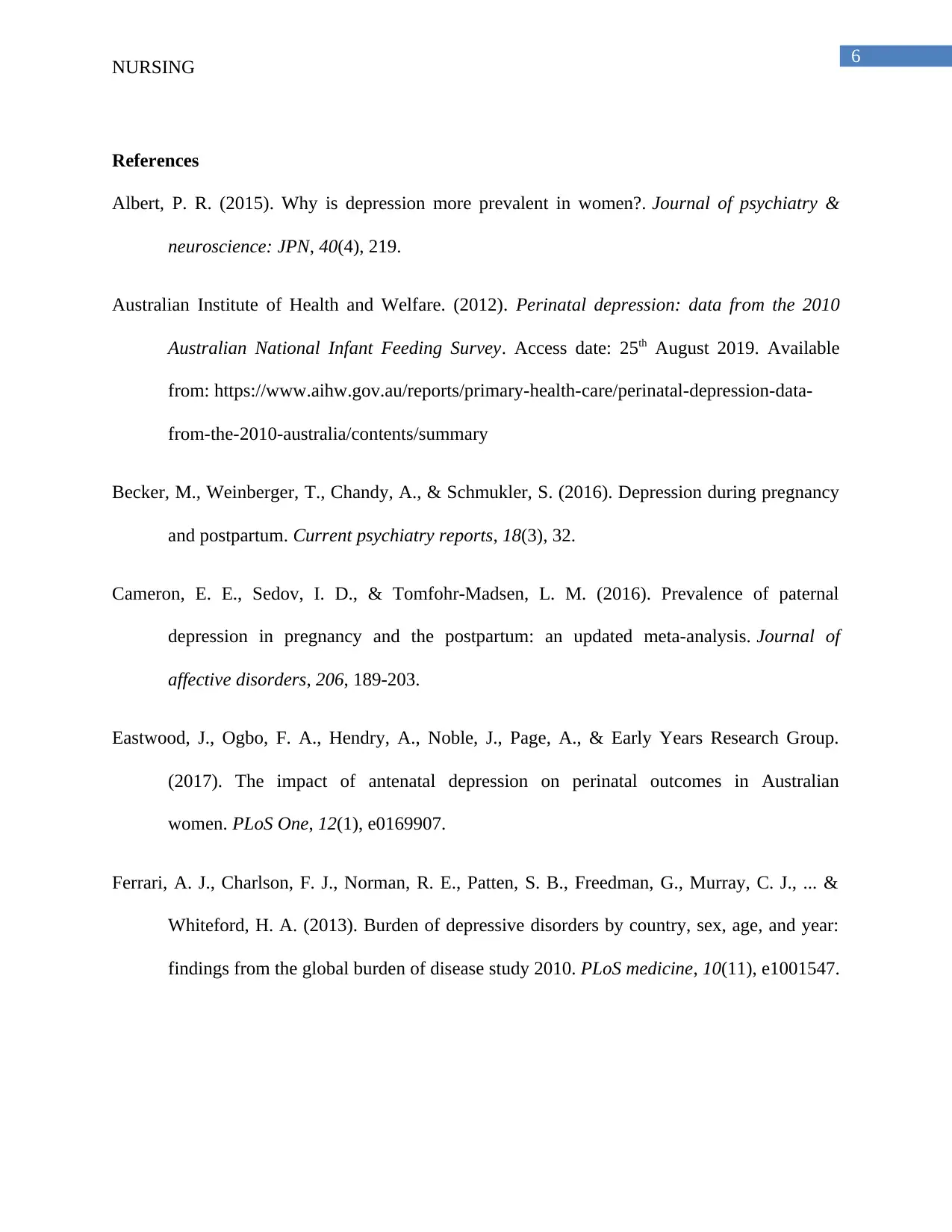
6
NURSING
References
Albert, P. R. (2015). Why is depression more prevalent in women?. Journal of psychiatry &
neuroscience: JPN, 40(4), 219.
Australian Institute of Health and Welfare. (2012). Perinatal depression: data from the 2010
Australian National Infant Feeding Survey. Access date: 25th August 2019. Available
from: https://www.aihw.gov.au/reports/primary-health-care/perinatal-depression-data-
from-the-2010-australia/contents/summary
Becker, M., Weinberger, T., Chandy, A., & Schmukler, S. (2016). Depression during pregnancy
and postpartum. Current psychiatry reports, 18(3), 32.
Cameron, E. E., Sedov, I. D., & Tomfohr-Madsen, L. M. (2016). Prevalence of paternal
depression in pregnancy and the postpartum: an updated meta-analysis. Journal of
affective disorders, 206, 189-203.
Eastwood, J., Ogbo, F. A., Hendry, A., Noble, J., Page, A., & Early Years Research Group.
(2017). The impact of antenatal depression on perinatal outcomes in Australian
women. PLoS One, 12(1), e0169907.
Ferrari, A. J., Charlson, F. J., Norman, R. E., Patten, S. B., Freedman, G., Murray, C. J., ... &
Whiteford, H. A. (2013). Burden of depressive disorders by country, sex, age, and year:
findings from the global burden of disease study 2010. PLoS medicine, 10(11), e1001547.
NURSING
References
Albert, P. R. (2015). Why is depression more prevalent in women?. Journal of psychiatry &
neuroscience: JPN, 40(4), 219.
Australian Institute of Health and Welfare. (2012). Perinatal depression: data from the 2010
Australian National Infant Feeding Survey. Access date: 25th August 2019. Available
from: https://www.aihw.gov.au/reports/primary-health-care/perinatal-depression-data-
from-the-2010-australia/contents/summary
Becker, M., Weinberger, T., Chandy, A., & Schmukler, S. (2016). Depression during pregnancy
and postpartum. Current psychiatry reports, 18(3), 32.
Cameron, E. E., Sedov, I. D., & Tomfohr-Madsen, L. M. (2016). Prevalence of paternal
depression in pregnancy and the postpartum: an updated meta-analysis. Journal of
affective disorders, 206, 189-203.
Eastwood, J., Ogbo, F. A., Hendry, A., Noble, J., Page, A., & Early Years Research Group.
(2017). The impact of antenatal depression on perinatal outcomes in Australian
women. PLoS One, 12(1), e0169907.
Ferrari, A. J., Charlson, F. J., Norman, R. E., Patten, S. B., Freedman, G., Murray, C. J., ... &
Whiteford, H. A. (2013). Burden of depressive disorders by country, sex, age, and year:
findings from the global burden of disease study 2010. PLoS medicine, 10(11), e1001547.
Paraphrase This Document
Need a fresh take? Get an instant paraphrase of this document with our AI Paraphraser
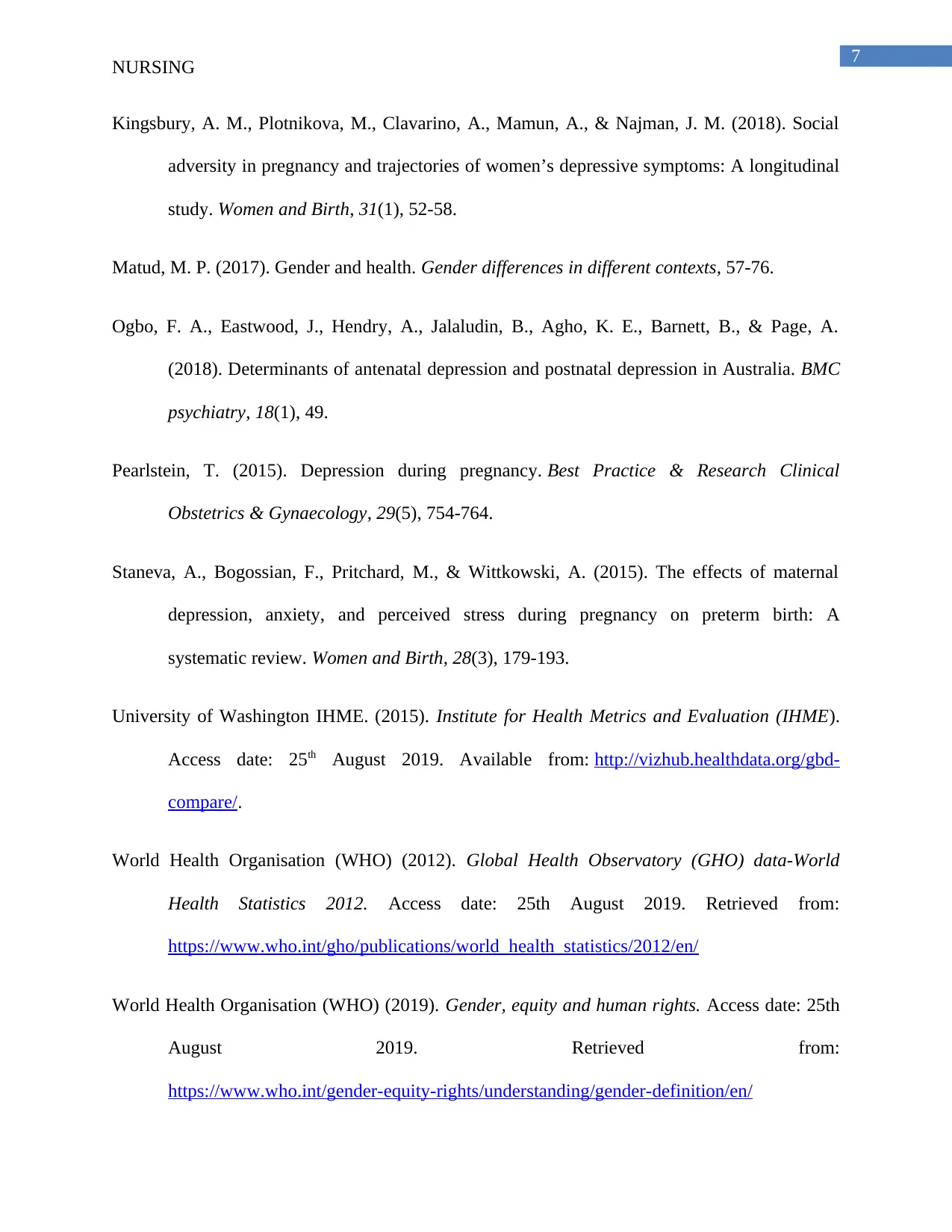
7
NURSING
Kingsbury, A. M., Plotnikova, M., Clavarino, A., Mamun, A., & Najman, J. M. (2018). Social
adversity in pregnancy and trajectories of women’s depressive symptoms: A longitudinal
study. Women and Birth, 31(1), 52-58.
Matud, M. P. (2017). Gender and health. Gender differences in different contexts, 57-76.
Ogbo, F. A., Eastwood, J., Hendry, A., Jalaludin, B., Agho, K. E., Barnett, B., & Page, A.
(2018). Determinants of antenatal depression and postnatal depression in Australia. BMC
psychiatry, 18(1), 49.
Pearlstein, T. (2015). Depression during pregnancy. Best Practice & Research Clinical
Obstetrics & Gynaecology, 29(5), 754-764.
Staneva, A., Bogossian, F., Pritchard, M., & Wittkowski, A. (2015). The effects of maternal
depression, anxiety, and perceived stress during pregnancy on preterm birth: A
systematic review. Women and Birth, 28(3), 179-193.
University of Washington IHME. (2015). Institute for Health Metrics and Evaluation (IHME).
Access date: 25th August 2019. Available from: http://vizhub.healthdata.org/gbd-
compare/.
World Health Organisation (WHO) (2012). Global Health Observatory (GHO) data-World
Health Statistics 2012. Access date: 25th August 2019. Retrieved from:
https://www.who.int/gho/publications/world_health_statistics/2012/en/
World Health Organisation (WHO) (2019). Gender, equity and human rights. Access date: 25th
August 2019. Retrieved from:
https://www.who.int/gender-equity-rights/understanding/gender-definition/en/
NURSING
Kingsbury, A. M., Plotnikova, M., Clavarino, A., Mamun, A., & Najman, J. M. (2018). Social
adversity in pregnancy and trajectories of women’s depressive symptoms: A longitudinal
study. Women and Birth, 31(1), 52-58.
Matud, M. P. (2017). Gender and health. Gender differences in different contexts, 57-76.
Ogbo, F. A., Eastwood, J., Hendry, A., Jalaludin, B., Agho, K. E., Barnett, B., & Page, A.
(2018). Determinants of antenatal depression and postnatal depression in Australia. BMC
psychiatry, 18(1), 49.
Pearlstein, T. (2015). Depression during pregnancy. Best Practice & Research Clinical
Obstetrics & Gynaecology, 29(5), 754-764.
Staneva, A., Bogossian, F., Pritchard, M., & Wittkowski, A. (2015). The effects of maternal
depression, anxiety, and perceived stress during pregnancy on preterm birth: A
systematic review. Women and Birth, 28(3), 179-193.
University of Washington IHME. (2015). Institute for Health Metrics and Evaluation (IHME).
Access date: 25th August 2019. Available from: http://vizhub.healthdata.org/gbd-
compare/.
World Health Organisation (WHO) (2012). Global Health Observatory (GHO) data-World
Health Statistics 2012. Access date: 25th August 2019. Retrieved from:
https://www.who.int/gho/publications/world_health_statistics/2012/en/
World Health Organisation (WHO) (2019). Gender, equity and human rights. Access date: 25th
August 2019. Retrieved from:
https://www.who.int/gender-equity-rights/understanding/gender-definition/en/
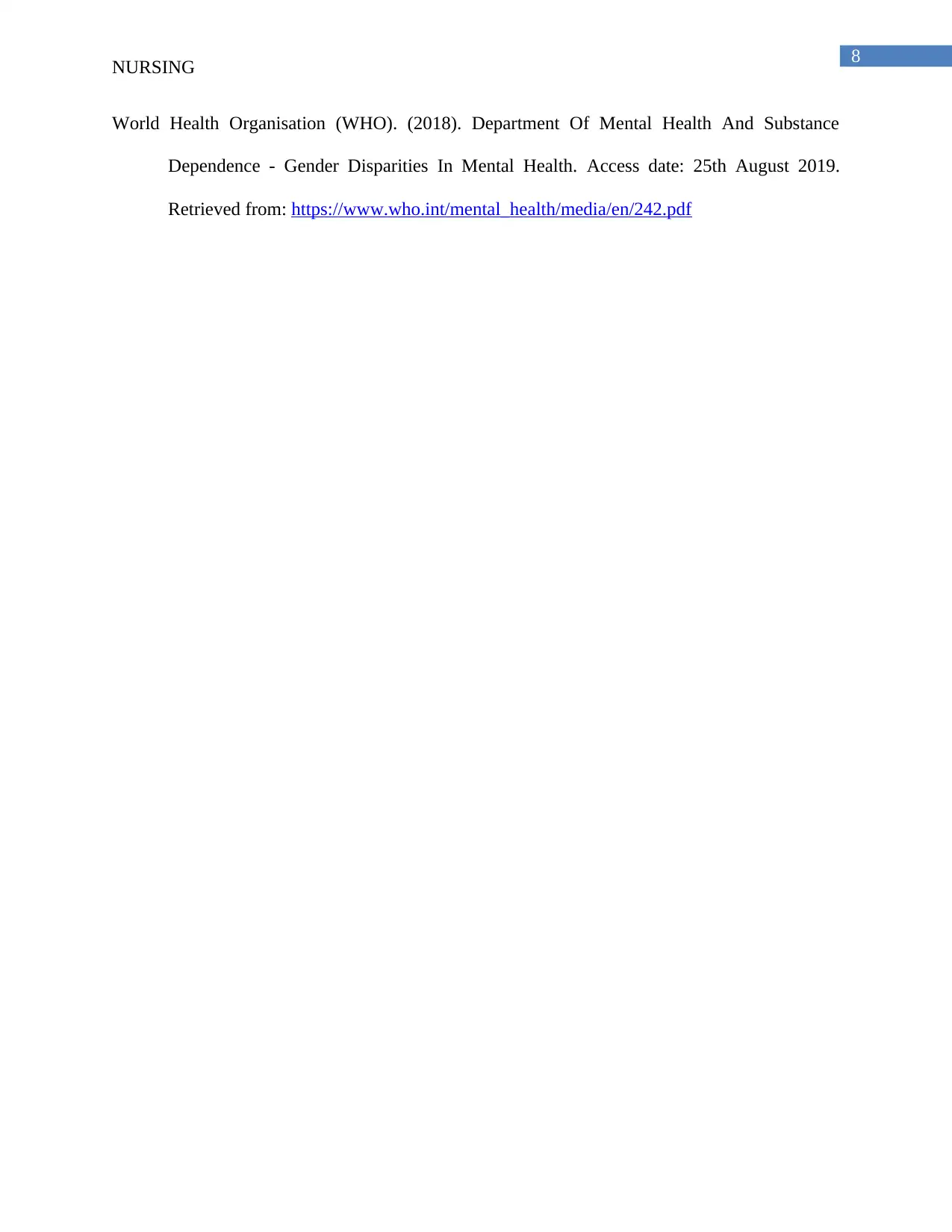
8
NURSING
World Health Organisation (WHO). (2018). Department Of Mental Health And Substance
Dependence - Gender Disparities In Mental Health. Access date: 25th August 2019.
Retrieved from: https://www.who.int/mental_health/media/en/242.pdf
NURSING
World Health Organisation (WHO). (2018). Department Of Mental Health And Substance
Dependence - Gender Disparities In Mental Health. Access date: 25th August 2019.
Retrieved from: https://www.who.int/mental_health/media/en/242.pdf
⊘ This is a preview!⊘
Do you want full access?
Subscribe today to unlock all pages.

Trusted by 1+ million students worldwide
1 out of 9
Related Documents
Your All-in-One AI-Powered Toolkit for Academic Success.
+13062052269
info@desklib.com
Available 24*7 on WhatsApp / Email
![[object Object]](/_next/static/media/star-bottom.7253800d.svg)
Unlock your academic potential
Copyright © 2020–2025 A2Z Services. All Rights Reserved. Developed and managed by ZUCOL.





